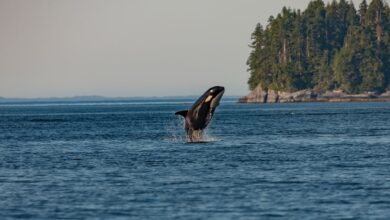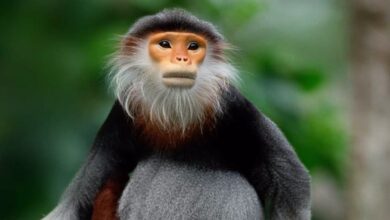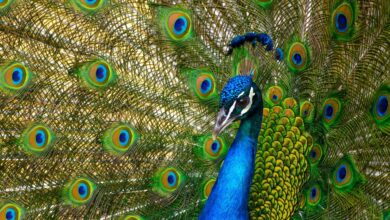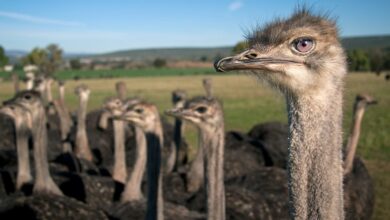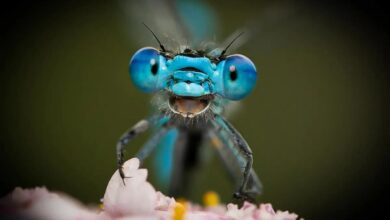Black Mambas
The Black mamba is a highly venomous snake found in Sub-Saharan Africa. After the King cobra, it is the second-longest venomous snake. These snakes can be olive, yellowish-brown, khaki, or gunmetal, but they are rarely black. The head of a black mamba is coffin-shaped, with a slightly pronounced brow ridge and a moderate eye.
Some individuals’ scales may have a purplish sheen. The underbelly of black mambas is grayish-white. Mamba eyes are grayish-brown to black, with a silvery-white or yellow ring around the pupil. Adult snakes are darker in color than juveniles, which are typically gray in color or olive green.
Characteristic
Adult Black mamba snakes have a maximum length of 4.5 meters and an average length of 2.5 meters (8.2 feet) (14 feet). The Black mamba snake gets its name from the black coloration inside its mouth rather than its grey to olive skin tone. It is the world’s fastest moving snake, capable of up to 20 kilometers per hour (12.5 miles per hour). However, it uses its speed to avoid danger rather than to catch prey.
Locations To Find A Black Mamba
The Central African Republic, the Democratic Republic of the Congo, Somalia, Ethiopia, Uganda, Eritrea, Kenya, Malawi, Mozambique, Zambia, South Africa, Zimbabwe, Botswana, Namibia, Tanzania, and Angola are all home to black mambas. These snakes prefer light woodland, semi-arid savanna, scrub, mountain peaks, rocky outcrops, and semi-arid savanna. They also live in moist savanna and lowland forests and may visit farms.
Habits and Lifestyle
Black mambas live both on the ground and in the trees. On the ground, they move with their heads and necks raised, and they usually seek shelter in termite mounds, rock crevices, abandoned burrows, and tree cracks. Black mambas live alone and are diurnal, basking in the morning and again in the afternoon. They may return to the same basking site daily. Black mambas are agile and fast, despite being skittish and often unpredictable. They rarely tolerate humans approaching them closer than 40 meters in the wild (130 ft).
The Black Mamba’s reputation for being aggressive is exaggerated; it is usually provoked by a potential threat such as blocking its movements and ability to retreat. Mambas flee into the brush or a hole when they sense danger. They are likely to engage in a threat display when confronted, gaping to reveal their black mouth and flicking their tongue. They may hiss and spread their neck-flap as well. Any sudden movement by the intruder during the threat display may provoke the snake into a series of rapid strikes, resulting in severe envenomation.
Black Mamba Diet
The black mamba is a diurnal snake that hunts prey at all hours of the day and night. The Black Mamba snake delivers a single lethal bite and then retreats, waiting for the toxic substance in its venom to paralyze the prey. When killing a bird, the Black Mamba snake will cling to it, preventing it from trying to escape.
These snakes have excellent vision and can strike their prey like lightning, killing rodents, bats, birds, and lizards with their powerful venom. Black mamba snakes move quickly across rough terrain or along low tree branches when hunting. Black mamba snakes can strike with their heads up to one meter above the ground and move with their heads up to 50 centimeters above the ground.
Mating Habits
Male and females are polygynandrous (promiscuous), which means they mate with multiple partners. During mating, the male will slither over the female’s dorsal side, flicking its tongue. The female will indicate her readiness to mate by lifting her tail and remaining motionless. From September to February is the breeding season.
Females lay a clutch of 6-17 eggs. The eggs are elongated ovals, 60-80 mm (2.4-3.1 in) long and 30-36 mm (1.2-1.4 in) in diameter. Incubation lasts approximately 2 to 3 months. When they hatch, the young are 40-60 cm (16-24 in) long. They can reach 2 m (6 ft 7 in) in length after their first year. They are self-sufficient from birth and must be able to care for themselves. Juvenile Black mambas are incredibly fearful and, like adults, can be lethal.
Venom
These snakes are among the world’s ten most venomous snakes. This snake is three times more venomous than the Cape Cobra, five times more venomous than the King Cobra, and forty times more venomous than the Gaboon viper. Black mamba venom contains potent, fast-acting neurotoxins (alters normal nervous system activity) and cardiotoxins (damaged heart muscle), including calciseptine.
The initial symptom of a bite in humans is local pain in the bite area, which is not as severe as in snakes with hemotoxins (toxins that destroy red blood cells). The victim then feels tingling in their extremities, drooping eyelids (eyelid ptosis), salivates excessively and loses muscle control (specifically the mouth and tongue).
If the victim does not seek medical attention, symptoms such as nausea, shortness of breath, confusion, and paralysis will develop rapidly.

